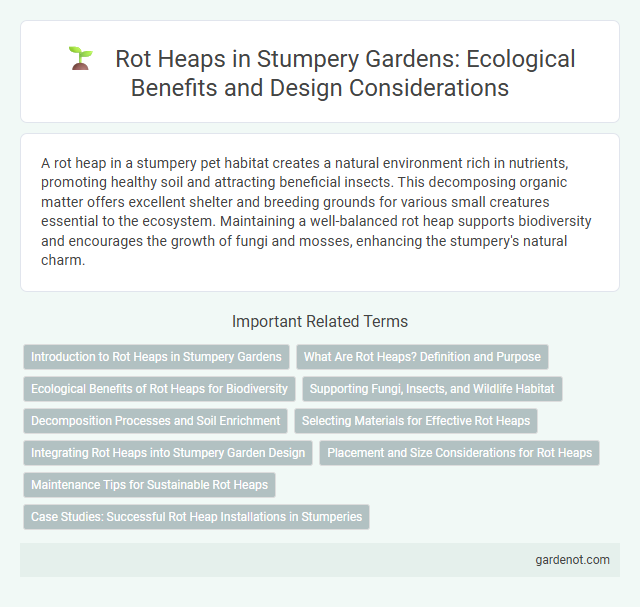A rot heap in a stumpery pet habitat creates a natural environment rich in nutrients, promoting healthy soil and attracting beneficial insects. This decomposing organic matter offers excellent shelter and breeding grounds for various small creatures essential to the ecosystem. Maintaining a well-balanced rot heap supports biodiversity and encourages the growth of fungi and mosses, enhancing the stumpery's natural charm.
Introduction to Rot Heaps in Stumpery Gardens
Rot heaps in stumpery gardens serve as vital composting zones where organic matter decomposes to enrich soil fertility naturally. These heaps create microhabitats supporting diverse fungi, invertebrates, and microorganisms essential for healthy garden ecosystems. Incorporating rot heaps enhances nutrient cycling, promotes robust plant growth, and sustains the unique biodiversity characteristic of stumperies.
What Are Rot Heaps? Definition and Purpose
Rot heaps are deliberately constructed piles of decaying wood, leaves, and plant material designed to support biodiversity in gardens and natural habitats. These heaps provide essential habitats for fungi, insects, amphibians, and small mammals, fostering decomposition processes that enrich soil health. By mimicking natural decay cycles, rot heaps play a crucial role in nutrient recycling and ecological balance.
Ecological Benefits of Rot Heaps for Biodiversity
Rot heaps create microhabitats that support decomposers such as fungi, bacteria, and invertebrates, crucial for nutrient recycling within stumperies. These heaps enhance soil fertility by breaking down organic matter, promoting the growth of diverse plant species and benefiting local wildlife. By fostering complex food webs, rot heaps contribute significantly to maintaining biodiversity and ecological balance in woodland ecosystems.
Supporting Fungi, Insects, and Wildlife Habitat
A rotting heap in a stumpery provides essential habitat and food sources for a diverse range of fungi, insects, and wildlife. Decaying wood and organic matter foster the growth of saprophytic fungi that break down complex organic compounds, enriching soil health and biodiversity. This microhabitat supports beetles, ants, and other invertebrates, which attract birds and small mammals, creating a vibrant ecological network.
Decomposition Processes and Soil Enrichment
Rot heaps accelerate organic matter decomposition by providing a controlled environment rich in microorganisms that break down leaves, branches, and other garden waste. The breakdown process releases essential nutrients like nitrogen, phosphorus, and potassium, enhancing soil fertility and promoting healthy plant growth. This natural decomposition cycle improves soil structure, increases moisture retention, and supports a diverse soil ecosystem.
Selecting Materials for Effective Rot Heaps
Choosing the right materials is essential for an effective rot heap, with a balance of green waste like kitchen scraps and fresh garden clippings, and brown waste such as dry leaves, straw, and cardboard. Including a variety of organic matter accelerates decomposition by fostering microbial activity and maintaining proper moisture and aeration levels. Avoiding meat, dairy, and diseased plants prevents pests and pathogens, ensuring a healthy, nutrient-rich compost.
Integrating Rot Heaps into Stumpery Garden Design
Integrating rot heaps into stumpery garden design enhances biodiversity by providing essential habitats for decomposers like fungi, insects, and worms. These natural composting areas enrich soil fertility, supporting the growth of mosses, ferns, and shade-loving plants typical in stumperies. Rot heaps also contribute to a sustainable garden ecosystem by recycling organic waste and maintaining moisture levels around the timber structures.
Placement and Size Considerations for Rot Heaps
Rot heaps should be placed in shaded, well-drained areas to promote efficient decomposition and reduce odor issues. Ideal size for a rot heap ranges between 1 cubic meter and 2 cubic meters, balancing material volume with airflow to maintain microbial activity. Positioning near garden beds or composting areas enhances nutrient recycling and soil enrichment.
Maintenance Tips for Sustainable Rot Heaps
Regularly turning the rot heap promotes aeration, accelerating decomposition and reducing unpleasant odors. Adding a balanced mix of green waste and brown materials maintains optimal moisture and nutrient levels, essential for efficient composting. Monitoring temperature and moisture helps sustain microbial activity, ensuring a healthy, sustainable rot heap.
Case Studies: Successful Rot Heap Installations in Stumperies
Successful rot heap installations in stumperies showcase effective decomposition processes, enhancing soil fertility and supporting native plant growth. Case studies highlight how properly managed rot heaps create microhabitats for fungi, invertebrates, and mosses, contributing to biodiversity within stumpery gardens. Incorporating organic waste materials such as bark, leaves, and woodchips optimizes nutrient cycling, resulting in healthier ecosystems and improved plant resilience.
Rot heap Infographic

 gardenot.com
gardenot.com